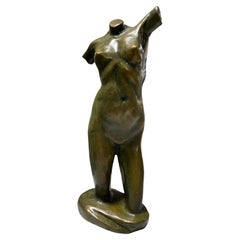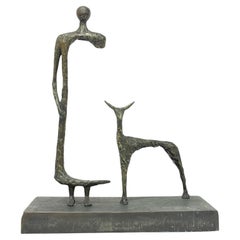Tom Corbin Sculpture
Early 2000s American Modern Figurative Sculptures
Bronze
Recent Sales
20th Century Canadian Mid-Century Modern Figurative Sculptures
Bronze
20th Century American Modern Figurative Sculptures
Marble, Bronze
20th Century American Modern Figurative Sculptures
Marble, Bronze
20th Century American Modern Abstract Sculptures
Bronze
20th Century American Modern Figurative Sculptures
Marble, Bronze
20th Century American Modern Abstract Sculptures
Bronze
20th Century American Modern Abstract Sculptures
Bronze
20th Century American Modern Abstract Sculptures
Bronze
20th Century American Modern Abstract Sculptures
Bronze
20th Century American Modern Abstract Sculptures
Bronze
20th Century American Modern Abstract Sculptures
Bronze
1990s American Modern Figurative Sculptures
Bronze
21st Century and Contemporary American Modern Figurative Sculptures
Bronze
21st Century and Contemporary American Modern Side Tables
Bronze
Late 20th Century American Modern Table Lamps
Bronze
20th Century Modern Figurative Sculptures
Bronze
20th Century Modern Nude Sculptures
Bronze
21st Century and Contemporary Animal Sculptures
Bronze
1990s American Modern Figurative Sculptures
Bronze
People Also Browsed
2010s Italian Mid-Century Modern Table Lamps
Brass
21st Century and Contemporary English Table Lamps
Bronze
2010s Chandeliers and Pendants
Metal
Vintage 1920s French Art Deco Figurative Sculptures
Marble, Bronze
2010s Italian Modern Chandeliers and Pendants
Brass
2010s Contemporary Figurative Sculptures
Metal, Bronze
2010s Swedish Scandinavian Modern Lounge Chairs
Sheepskin, Beech
2010s South African Minimalist Night Stands
Wood
21st Century and Contemporary American Night Stands
Oak, Wood, Walnut
Late 20th Century French Mid-Century Modern Side Tables
Iron, Wrought Iron
21st Century and Contemporary American Post-Modern Coffee and Cocktail T...
Oak
1920s Romantic Figurative Sculptures
Bronze
Late 20th Century French Mid-Century Modern Console Tables
Wrought Iron
1980s Modern Figurative Sculptures
Bronze
Felipe Castañeda"Untitled" bronze sculpture of seated female figure by artist Felipe Castañeda, 1984
Vintage 1950s Finnish Scandinavian Modern Table Lamps
Brass
1990s French Post-Modern Table Lamps
Gold, Bronze
A Close Look at Modern Furniture
The late 19th and early 20th centuries saw sweeping social change and major scientific advances — both of which contributed to a new aesthetic: modernism. Rejecting the rigidity of Victorian artistic conventions, modernists sought a new means of expression. References to the natural world and ornate classical embellishments gave way to the sleek simplicity of the Machine Age. Architect Philip Johnson characterized the hallmarks of modernism as “machine-like simplicity, smoothness or surface [and] avoidance of ornament.”
Early practitioners of modernist design include the De Stijl (“The Style”) group, founded in the Netherlands in 1917, and the Bauhaus School, founded two years later in Germany.
Followers of both groups produced sleek, spare designs — many of which became icons of daily life in the 20th century. The modernists rejected both natural and historical references and relied primarily on industrial materials such as metal, glass, plywood, and, later, plastics. While Bauhaus principals Marcel Breuer and Ludwig Mies van der Rohe created furniture from mass-produced, chrome-plated steel, American visionaries like Charles and Ray Eames worked in materials as novel as molded plywood and fiberglass. Today, Breuer’s Wassily chair, Mies van der Rohe’s Barcelona chair — crafted with his romantic partner, designer Lilly Reich — and the Eames lounge chair are emblems of progressive design and vintage originals are prized cornerstones of collections.
It’s difficult to overstate the influence that modernism continues to wield over designers and architects — and equally difficult to overstate how revolutionary it was when it first appeared a century ago. But because modernist furniture designs are so simple, they can blend in seamlessly with just about any type of décor. Don’t overlook them.
Finding the Right Sculptures for You
Styling your home with vintage, new and antique sculptures means adding a touch that can meaningfully transform the space. By introducing a sculptural work as a decorative finish to any interior, you’re making a statement, whether you tend toward the dramatic or prefer to keep things casual with modest, understated art.
A single, one-of-a-kind three-dimensional figurative sculpture mounted on your dining room wall is a guaranteed conversation piece, while a trio of abstract works arranged on your living room bookshelves can add spontaneity to the collection of first-edition novels or artist monographs you’re displaying as well as draw attention to them. Figurative sculptures are representational works that portray a specific person, animal or object. And while decorating with busts, which are sculpted or cast figurative works, hasn’t exactly topped the list of design trends every year, busts are back. According to designer Timothy Corrigan, “They give humanity in a way that a more abstract sculpture can’t give.” Abstract sculptures, on the other hand, are not meant to show something specific. Instead, they invoke a mood or scene without directly stating what they are portraying.
Busts made of stone or metal may not seem like a good fit for your existing decor. Fortunately, there are many ways for a seemingly incongruous piece to fit in with the rest of your room’s theme. You can embrace a dramatic piece by making it the focal point of the room, or you can choose to incorporate several elements made out of the same material to create harmony in your space. If an antique or more dramatic piece doesn’t feel like you, why not opt for works comprising plastic, fiberglass or other more modern materials?
When incorporating sculpture into the design of your home — be it the playful work of auction hero and multimedia visionary KAWS, contemporary fiber art from Connecticut dealer browngrotta arts or still-life sculpture on a budget — consider proper lighting, which can bring out the distinctive aspects of your piece that deserve attention. And make sure you know how the size and form of the sculpture will affect your space in whole. If you choose a sculpture with dramatic design elements, such as sharp angles or bright colors, for example, try to better integrate this new addition by echoing those elements in the rest of your room’s design.
Get started on decorating with sculpture now — find figurative sculptures, animal sculptures and more on 1stDibs today.


